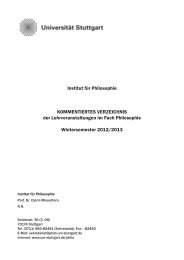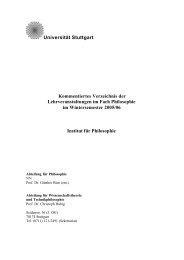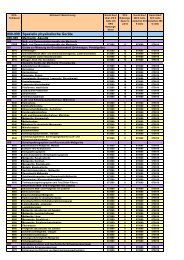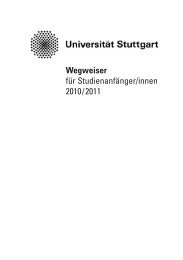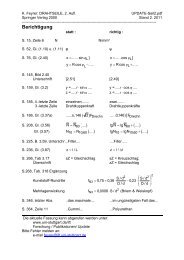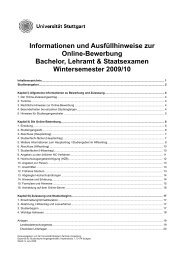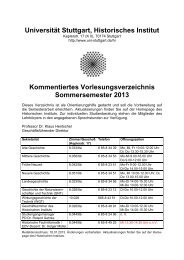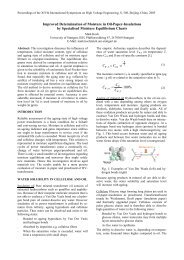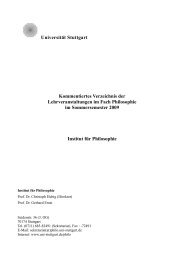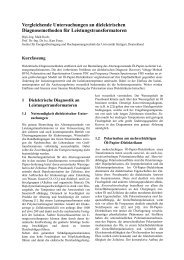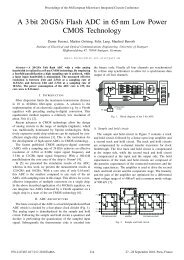Discourse Structure and the Structure of Context - Multiple Choices
Discourse Structure and the Structure of Context - Multiple Choices
Discourse Structure and the Structure of Context - Multiple Choices
Create successful ePaper yourself
Turn your PDF publications into a flip-book with our unique Google optimized e-Paper software.
38<br />
throughout. In such a situation KUtt is, at least as far as n is concerned,<br />
immutable. The situation is different, when utterance times are<br />
determined by utterances which cover only a small part <strong>of</strong> <strong>the</strong><br />
discourse (e.. <strong>the</strong> utterance <strong>of</strong> an indexical expression on its own, or <strong>of</strong><br />
<strong>the</strong> sentence in which <strong>the</strong> expression occurs). In that case KUtt changes<br />
beteen utterances belonging to <strong>the</strong> same discourse <strong>and</strong> thus shows a<br />
kind <strong>of</strong> dynamics. 29<br />
2. In English <strong>and</strong> also in many o<strong>the</strong>r languages <strong>the</strong>re is a range <strong>of</strong><br />
indexical temporal expressions, whose interpretation depends on <strong>the</strong><br />
29 Cases in which <strong>the</strong> utterance time is taken to be that <strong>of</strong> <strong>the</strong> entire discourse<br />
present a certain difficulty, especially when we assume that <strong>the</strong>y involve anchoring <strong>of</strong><br />
n to this discourse time. It is quite common for <strong>the</strong> discourse participants to take <strong>the</strong><br />
utterahnce time as that <strong>of</strong> <strong>the</strong> entire discourse without having any clear idea, durin<br />
<strong>the</strong> early part <strong>of</strong> <strong>the</strong>ir conversation for how long it will og on; <strong>and</strong>, indeed, this may<br />
be genuinely undetermined when <strong>the</strong> conversation begins. In this case <strong>the</strong> period to<br />
which n is anchored is not yet fixed <strong>and</strong> it might be wondered how anchoring would<br />
be possible in such cases.<br />
As a matter <strong>of</strong> fact I do take this to be a serious problem. As soon as <strong>the</strong> discourse<br />
begins, its time is accessible to <strong>the</strong> participants - as <strong>the</strong> time <strong>of</strong> <strong>the</strong> discourse that has<br />
just started - <strong>and</strong> <strong>the</strong> fact that <strong>the</strong> full extent <strong>of</strong> his time is still indeterminate desn't<br />
prevent it from serving as an anchor. (More ought to be said about exactly what this<br />
implies for <strong>the</strong> notion <strong>of</strong> anchoring we have been using, but this would lead too far<br />
afield.)<br />
I believe, however, that <strong>the</strong> indeterminacy <strong>of</strong> <strong>the</strong> time <strong>of</strong> <strong>the</strong> entire discourse has an<br />
important implication. Because in so many cases <strong>the</strong> full extent <strong>of</strong> <strong>the</strong> global<br />
utterance time cannot be determined until <strong>the</strong> discourse has actually come to a<br />
conclusion, it is part <strong>of</strong> interpretations which make use <strong>of</strong> this default strategy to take<br />
<strong>the</strong> utterance time to be inherently indeterminate, with <strong>the</strong> attendant constraint that<br />
<strong>the</strong> result <strong>of</strong> interpretation should not depend on what <strong>the</strong> utterance time will turn<br />
out to be in <strong>the</strong> end. Extrapolating from this we arrive at <strong>the</strong> constraint that<br />
intrpretation should be independent <strong>of</strong> which subinterval <strong>of</strong> <strong>the</strong> duration <strong>of</strong> <strong>the</strong> entire<br />
discourse is assumed as utterance time. it is easily seen that this constraint restricts<br />
what can be said to precisely <strong>the</strong> three possibilites listed in (3): ei<strong>the</strong>r ev lis in <strong>the</strong><br />
future <strong>of</strong> <strong>the</strong> entire discourse, in which <strong>the</strong> appropriate tense is a future tense, or ev<br />
has ended before <strong>the</strong> discourse started, in which a past tense is appropriate; or ev<br />
spans <strong>the</strong> entire duration <strong>of</strong> <strong>the</strong> entire discourse, in which present tense is<br />
appropriate, with <strong>the</strong> additional proviso that ev is <strong>the</strong> kind <strong>of</strong> eventuality that is<br />
interpreted as including tloc, ra<strong>the</strong>r than being included in it. (It is easy to verify that<br />
when <strong>and</strong> only when we presupppose that <strong>the</strong> eventuality described by a sentence S<br />
satisfies one <strong>of</strong> <strong>the</strong>se three possibilities that it becomes immaterial which subinterval<br />
<strong>of</strong> <strong>the</strong> discourse duration is chosen in interpreting S.) A discourss whose sentences<br />
satisfy this presuppopsition is semantically robust in that <strong>the</strong> truth conditions which<br />
interpetation assigns to <strong>the</strong>m are indpendent <strong>of</strong> what - within <strong>the</strong> duration <strong>of</strong> <strong>the</strong><br />
discourse as a whole - is taken as <strong>the</strong> relevant utterance time. This is an alternative<br />
way <strong>of</strong> explaining why <strong>the</strong> tripartite division <strong>of</strong> (3) should hold.



